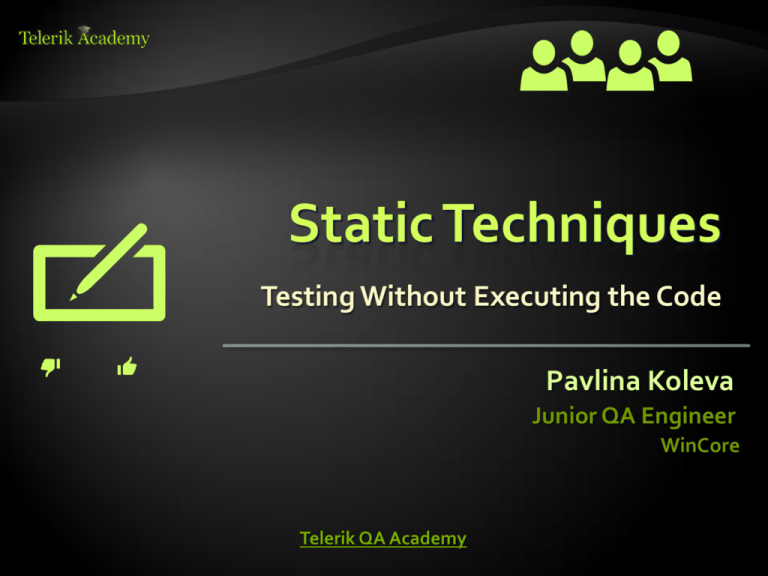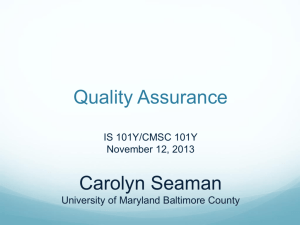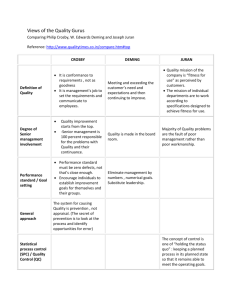Static Techniques
advertisement

Static Techniques Testing Without Executing the Code Pavlina Koleva Junior QA Engineer WinCore Telerik QA Academy Table of Contents Static Techniques – Main Concepts Static Analysis by Tools Reviews 2 Static Techniques Main Concepts What is Static Testing What is static testing? Static testing can be defined as testing a system without executing its code Static testing can be two main types: Manual examination – reviews Automated analysis – static analysis 4 What Can Static Analysis Be Used For Typical defects that are easier to find in reviews than in dynamic testing include: Deviations from standards Requirement defects Design defects Insufficient maintainability Incorrect interface specifications 5 Why Should We Use It Defects found early by reviews are cheaper to fix Static techniques find causes (sources) of failures (defects) rather than the failures themselves Static analysis supplements dynamic testing for a better and more efficient test coverage 6 Advantages Of Static Testing Static testing finds defects that are difficult to find by dynamic testing E.g., detecting violation of certain programming standards Use of forbidden error-prone program constructs Potential performance issues Potential security issues 7 Static Analysis by Tools ⚒ Static Analysis The term static analysis refers to using tools for automated code analysis Static analysis can locate defects that are hard to find with dynamic testing Static analysis finds potential defects rather than failures 9 Deriving Metrics An additional objective of static analysis is to derive measurements, or metrics In order to measure and prove the quality Typical measures are: CPU and memory consumption Number of calls to a method How many times a variable has been accessed Done by tools ⏳ called profilers 10 Static Analysis Targets Static analysis tools can be used to analyze: Program code E.g. control flow and data flow Generated output E.g. DLL, HTML and XML ░░ ✅ 11 Finding Security Problems Static analysis can be used in order to detect security problems Error-prone program constructs used Necessary checks are not done Examples: Lack of buffer overflow protection Failing to check that input data may be out of bounds 12 Formal Documents The document to be analyzed must follow a certain formal structure In order to be checked by a tool Formal documents can be The technical requirements The software architecture The software design UML, HTML or XML documents E.g. class diagrams in UML 13 The Compiler is an Analysis Tool All compilers carry out a static analysis of the program under test Making sure that the correct syntax of the programming language is used Further information can be generated Undeclared variables Unreachable code Overflow or underflow of field boundaries http://en.wikipedia.org/wiki/List_of_tools_for_s tatic_code_analysis 14 Reviews Human-Driven Examination of the Code What is a Review What is a review (quality review)? A type of static testing Could be code review, design review, test plan review, documentation review, etc. A process or meeting during which a software product is examined by someone In most cases done by the team members To ascertain discrepancies from planned results To recommend improvements Finds defects by directly examining documents 16 What Can Be Reviewed? All types of documents can be subjected to a review Source code Requirements specifications Concepts Test plans Test documents Etc. 17 Objectives of Reviews Reviews can have various objectives Finding defects Building confidence That we can proceed with the item under review Ensuring uniform understanding of the document Building consensus around the statements in the document 18 Formal vs. Informal Reviews The level of formality of different types of reviews can vary Informal Includes no written instructions for reviewers Systematic Including team participation Documented results of the review Documented procedures for conducting the review 19 What Types of Reviews Are There By level of formality Formal Informal By expertise of the reviewers Technical Non-technical 20 Formal Review Phases Planning Selecting the personal, allocating roles, defining entry and exit criteria Kick-off Distributing documents, explaining the objectives, checking entry criteria Individual preparation 21 Formal Review Phases Review meeting Rework Fixing defects found, typically done by the author Fixing defects found, typically done by the author Follow-up Checking the defects have been addressed, gathering metrics and checking on exit criteria 22 Roles and Responsibilities ♝ ✍ 23 Manager Manager Decides on the execution of reviews Allocates time in project schedules Determines if the review objectives have been met ♔ 24 Moderator Moderator Leads the review of the document or set of documents Planning the review Running the meeting ♝ Following-up after the meeting The moderator may mediate between the various points of view Often he is the person upon whom the success of the review rests 25 Author Author The writer or person with chief responsibility for the document(s) to be reviewed ✍ 26 Reviewers Reviewers (checkers, inspectors) Individuals with a specific technical or business background Identify and describe findings (e.g., defects) in the product under review After the necessary preparation Should be chosen to represent different perspectives and roles in the review process Should take part in any review meetings 27 Scribe (Recorder) Scribe (or recorder) Documents all the issues, problems and open points that were identified during the meeting 28 Common Types of Reviews Phases and Roles Common Types of Reviews A review can be performed in a different form: Informal review Walkthrough Technical review Inspection Peer review 30 Informal Review Informal review No formal process May take the form of pair programming or a technical lead reviewing designs and code Results may be documented Varies in usefulness Depending on the reviewers Main purpose: inexpensive way to get some benefit 31 Walkthrough Walkthrough Meeting led by author May take different form: Scenarios Dry runs Peer group participation Sessions open-ended Optional pre-meeting preparation of reviewers Optional preparation of a review report including list of findings 32 Walkthrough (2) Walkthrough Optional scribe Not the author May vary in practice From quite informal to very formal Main purposes: Learning Gaining understanding Finding defects 33 Technical Review Technical Review Documented, defined defect-detection process Includes peers and technical experts Optional management participation May be performed as a peer review without management participation Ideally led by trained moderator Not the author Pre-meeting preparation by reviewers 34 Technical Review (2) Technical Review Optional use of checklists Preparation of a review report which includes List of findings Verdict whether the software product meets its requirements Recommendations related to findings (where appropriate) May vary in practice From quite informal to very formal 35 Technical Review (3) Technical Review Main purposes: Discussing Making decisions Evaluating alternatives Finding defects Solving technical problems Checking conformance to specifications, plans, regulations, and standards 36 Inspection Inspection Led by trained moderator Not the author Usually conducted as a peer examination Defined roles Includes metrics gathering Formal process Based on rules and checklists 37 Inspection (2) Inspection Specified entry and exit criteria for acceptance of the software product Pre-meeting preparation Inspection report including list of findings Formal follow-up process Optional process improvement components Optional reader Main purpose: finding defects 38 Peer Review Peer review Reviews performed within a peer group I.e. colleagues at the same organizational level Can be used for: Walkthroughs Technical reviews Inspections 39 Reviews Conclusions and Examples ✔ Ⓘ ✔ Ⓑ ✔ Ⓘ ✘ ✘ ✘ ✔ ✘ ✔ Ⓘ ✔ ✔ Ⓘ Ⓑ 40 Static Techniques Questions?




